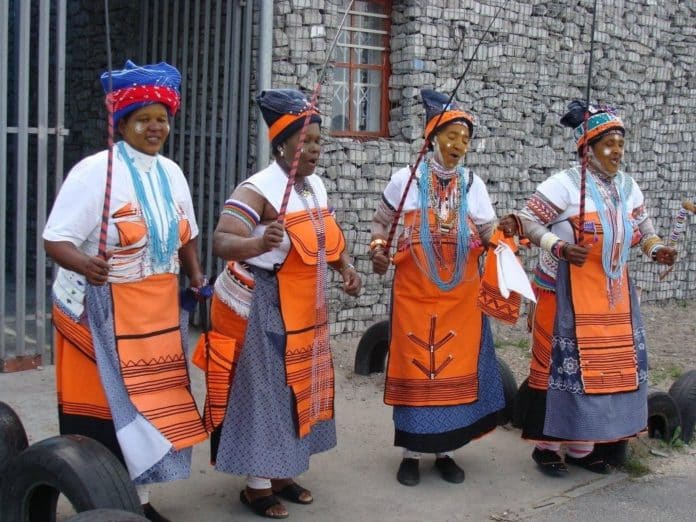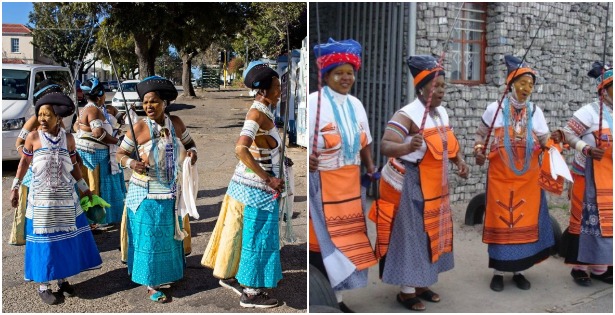- The Xhosa culture of South Africa is a rich heritage comprising various intriguing traditions.
- Their unique way of life plays a role in their general outlook on life and belief system.
- The article centers on the splitting of their tribes, their dressing and rituals.
Xhosa culture and tribes
The AmaXhosa are one of the four Nguni ethnic groups that inhabit South Africa.
AmaZulu, AmaSwazi, and AmaNdebele make up the other three.
After settling in the Eastern Cape, the AmaXhosa eventually migrated to the Western Cape.
Tribes and clans make up the Xhosa people. Families belonging to a clan may have distinct last names, but they all use the same clan name.
For instance, AmaHlubi is the name of the country, but Radebe is the clan. The name of the first family or ancestor from which the clan descended is its clan name. Tribes and nations are both made out of clans.
READ ALSO: Funeral Culture in Nigeria: Custom, Ceremony, What to Expect
The spoken language, IsiXhosa, features clicks. For instance, the English letters X, Q, KR, and CG are click-forming letters.
The art of storytelling is very important in this culture, and storytelling is also present in the music.
Particularly the dance style known as umtyityimbo, which calls for performers to make their upper bodies shiver and vibrate while dancing, Xhosa dance is something of a wonder.

Xhosa culture traditional attire
Xhosa culture consists of clothing that is weaved from cotton in distinctive designs.
The women are dressed in white dresses with black bias binding at the neck and hem, along with elaborate headpieces made of two or three different coloured materials.
The colour of the headdresses signify the many regions they are from.
Married women cover their clothes with long aprons that are embellished with black bias binding, and they then cover the entire ensemble with a cloak made of the same material.
Isikhakha is the name of this attire. Inxili, a sling bag worn by women and used as a handbag.
In Xhosa culture, ladies must always wear jewelry. Beads are used to make traditional Xhosa jewelry, including earrings, necklaces, and collars.
Collars come in a variety of sizes; some extend to the shoulders while others flow halfway down the upper arm.
The beads are available in every shade of the rainbow, and they shine brightest when constructed with primary hues like red, blue, dark blue, white, and yellow.
The wraparound skirts worn by Xhosa males extend all the way to their feet. When it gets cold, they wrap a large scarf over one shoulder so that it doubles as a cloak.
Depending on the tribal traditions, they don headdresses made of cloth or beads.
Xhosa culture rituals
Xhosas learn the art of stick combat at a young age when herding cattle in the veld (pastures).
They will utilise this ability to defend themselves and their families, therefore this is where the training will begin. The majority of the sticks that Xhosa men carry were gifts from their ritual circumcision.
Face painting, or umchokozo, is very important in Xhosa culture. Women use white or yellow ochre to paint patterns on their faces using dots.
On occasion, the designs are painted across the wearer’s cheekbones, nasal bridge, and brows.
AmaXhosa people, like all Africans, consider their ancestors to be a conduit for their interactions with God. Imbeleko, a birth ceremony, is carried out to introduce the newborn to their ancestors and vice versa.
A kid will get his circumcision at the age of 18, which is regarded as the beginning of the transition from boyhood to manhood.
In the bush, older men mentor young men and impart lessons about manhood. They are being prepared for life, leadership, and maintaining their culture through this ceremony.
Young males cover their bodies with white ochre during the first portion of the ceremony and red ochre during the last stages.
In addition to serving as a deodorant, ochre shields the skin from diseases and microorganisms. The young men wash all the ochre off after their time in the jungle is through, revealing beautiful, velvety skin. Additionally, girls have an intonjana ritual that marks the shift from being a girl to being a lady.
Xhosa culture on marriage
A young man’s family will approach the woman’s family and request her hand in marriage when he is ready.
A dowry is paid to the bride’s family prior to the wedding as a token of appreciation for raising the young woman who will soon leave her home and become a lifelong member of her fiancé’s family.
People execute rites of death when they pass away. If the family patriarch passes away, a bull, which will be butchered at his funeral, will follow him in spirit.
Another bull will be killed a year after his passing so that his spirit can return to his family’s house and reside there, guiding and guarding them. When a person’s spouse passes away, they must observe a one-year period of mourning.
Depending on the family’s beliefs, women dress in black or traditional garb, and men may have a button wrapped in black cloth, a little piece of black cloth pinned to the front or sleeve of his shirt, or both. A ritual of purification is carried out when the period of grieving is through.
READ ALSO: This is our culture: Beautiful bride uses teeth to cook on her wedding day
Igbo People: History, Culture, Religion
Meanwhile, the Igbo, also Ibo, Ebo, Eboe, and Eboans, are an ethnic group in Nigeria. They are the second largest group of people living in southern Nigeria, following the Yoruba.
They are socially and culturally diverse, consisting of many subgroups. Although they live in scattered groups of villages, they all speak one language.
There has been much speculation about the origins and history of the Igbo people, which are largely unknown.





